Alder paneling offers a smooth texture and warm, reddish-brown hues that enhance interior aesthetics, while pine paneling is softer with a lighter color and prominent knots, providing a rustic and affordable option. Alder is more durable and resists dents better than pine, making it ideal for high-traffic areas.
Table of Comparison
| Feature | Alder | Pine |
|---|---|---|
| Wood Type | Hardwood | Softwood |
| Color | Light reddish-brown | Light yellow to pale brown |
| Grain | Straight, fine grain | Pronounced knots, straight grain |
| Durability | Moderately durable | Less durable, prone to dents |
| Workability | Easy to work and stain | Very easy to work, accepts paint well |
| Cost | Moderate | Low |
| Common Uses | Interior paneling, cabinetry | Wall paneling, rustic decor |
Introduction to Alder and Pine for Paneling
Alder and pine are popular wood choices for paneling, each offering unique characteristics and aesthetic appeal. Alder features a smooth grain with warm, reddish tones that darken over time, making it ideal for creating a cozy, rich interior atmosphere. Pine presents a lighter, natural look with prominent knots and a softer texture, providing a rustic charm and affordability for various paneling projects.
Appearance and Grain Patterns
Alder paneling features a warm, rich color with subtle reddish-brown hues and smooth, consistent grain patterns that create a refined, elegant look ideal for cozy interior designs. Pine offers a lighter, more rustic appearance with visible knots and pronounced grain lines, adding character and a natural, rugged texture suited for casual or farmhouse styles. Choosing between alder and pine depends on the desired aesthetic, with alder providing a polished, uniform grain while pine brings a more organic, textured visual appeal.
Durability and Hardness Comparison
Alder wood is softer with a Janka hardness rating of around 590, making it less durable and more prone to dents and scratches compared to Pine, which has a Janka hardness of approximately 870, offering increased resistance to wear. Pine's higher density and hardness contribute to a longer lifespan for paneling, especially in high-traffic or impact-prone areas. While Alder provides a smoother finish ideal for staining and detailed work, Pine's robustness makes it a preferred choice for durability-focused applications.
Workability and Installation Ease
Alder paneling offers superior workability due to its softer grain, allowing for easier cutting, shaping, and sanding compared to the harder, resinous pine. Pine's installation can be more challenging because it tends to splinter and may require pre-drilling for nails or screws, whereas alder panels typically provide smooth fastening with less risk of damage. Both woods are suitable for interior paneling, but alder is preferred for projects demanding precise craftsmanship and quicker installation.
Cost Differences Between Alder and Pine
Alder paneling typically costs more than pine due to its finer grain and smoother finish, making it a premium choice for interior design projects. Pine, being more abundant and faster growing, offers a budget-friendly option with a rustic appearance that appeals to cost-conscious homeowners. Choosing between alder and pine paneling hinges largely on balancing upfront material expenses with the desired aesthetic and durability.
Stainability and Finish Options
Alder wood offers excellent stainability with a smooth, even grain that readily absorbs stain, producing a uniform finish ideal for various color tones. Pine, characterized by its prominent knots and resinous nature, can be more challenging to stain evenly but accepts paint and clear finishes well, highlighting its natural patterns. Both woods provide versatile finishing options, yet alder's consistent texture makes it preferable for achieving a refined, polished appearance in paneling projects.
Maintenance and Longevity
Alder paneling requires more frequent maintenance due to its softer wood structure, making it prone to dents and scratches, while pine paneling is more durable and resistant to wear over time. Pine's natural resin content enhances its longevity by providing greater resistance to moisture and pests compared to alder. Proper sealing and regular upkeep can extend the lifespan of both wood types, but pine generally offers lower maintenance needs and better long-term durability for interior paneling.
Environmental Impact and Sustainability
Alder paneling offers a lower environmental impact due to its faster growth rate and widespread availability, making it a more renewable resource compared to pine. Pine trees generally require longer maturation periods, which can contribute to higher carbon sequestration but also increase deforestation risks if not sustainably managed. Choosing certified sustainably harvested alder or pine wood ensures the paneling supports responsible forestry practices and reduces ecological footprints.
Best Applications for Each Wood Type
Alder paneling is ideal for interior spaces requiring a warm, rustic aesthetic due to its fine, uniform grain and smooth texture, making it perfect for furniture, cabinetry, and decorative wall surfaces. Pine excels in applications needing durability and affordability, often used in rustic or country-style interiors where its knotty character enhances the natural look, making it suitable for ceilings, trim, and paneling in cabins or casual living spaces. Both woods accommodate staining and finishing well, but alder's consistent grain lends itself better to modern finishes, while pine's resin content offers excellent hold for paints and stains in high-traffic areas.
Final Considerations: Choosing Between Alder and Pine
Alder offers a smooth, consistent grain and warm reddish tones that enhance interior paneling with a refined, elegant look, while pine provides a lighter, knotty appearance that adds rustic charm and affordability to wall treatments. Both woods are soft and easy to work with, but alder is more resistant to dents and scratches compared to pine, making it ideal for higher-traffic areas. Final consideration depends on desired aesthetic, durability, and budget, with alder suited for polished interiors and pine favored for casual, cost-effective projects.

Infographic: Alder vs Pine for Paneling
 azmater.com
azmater.com